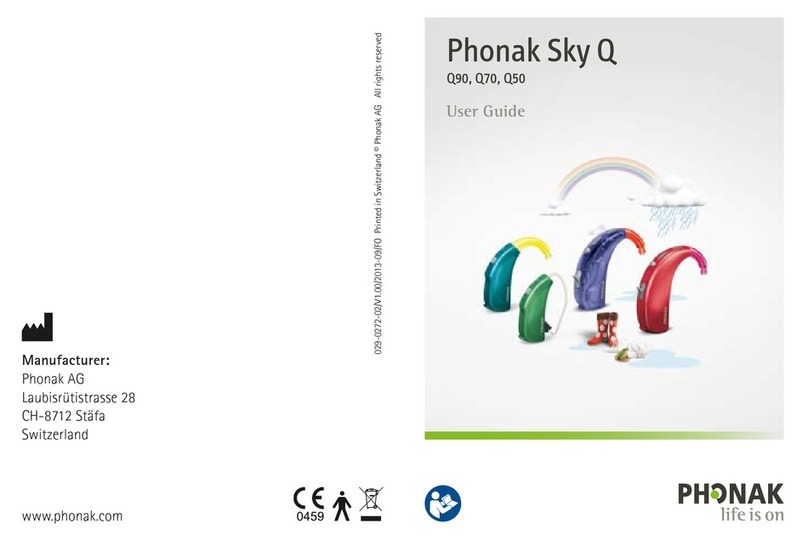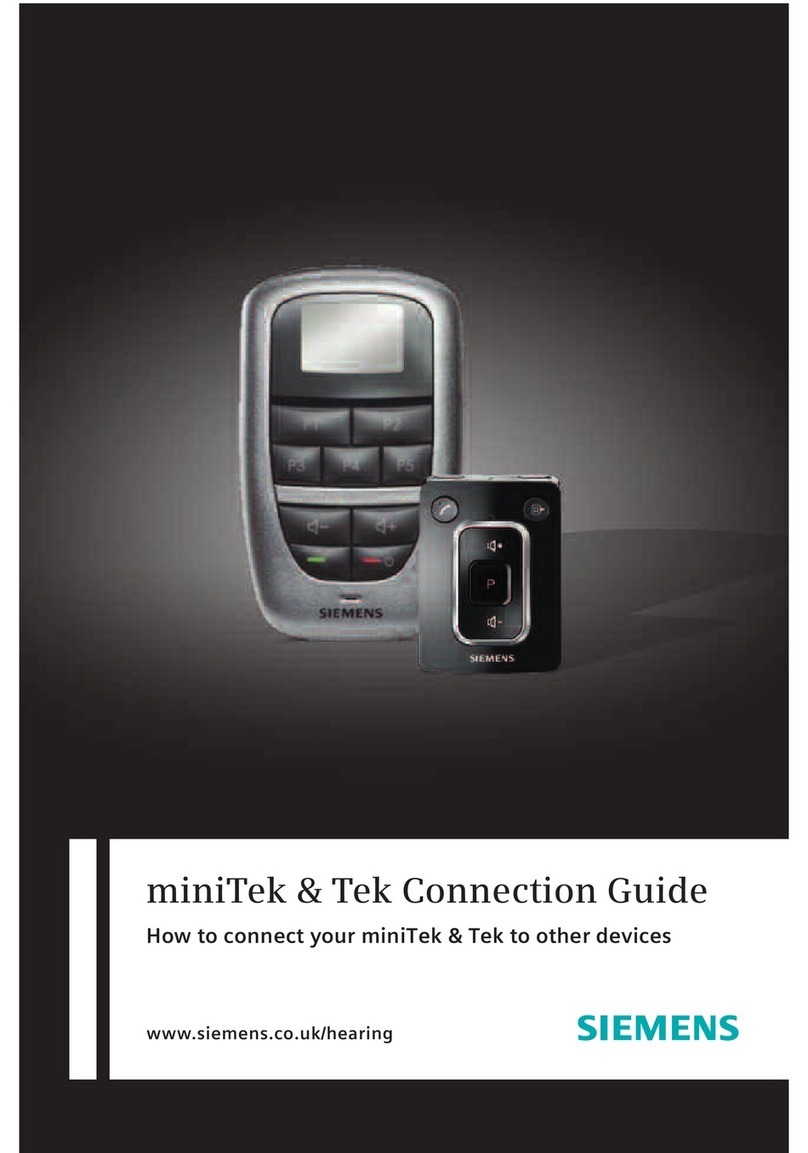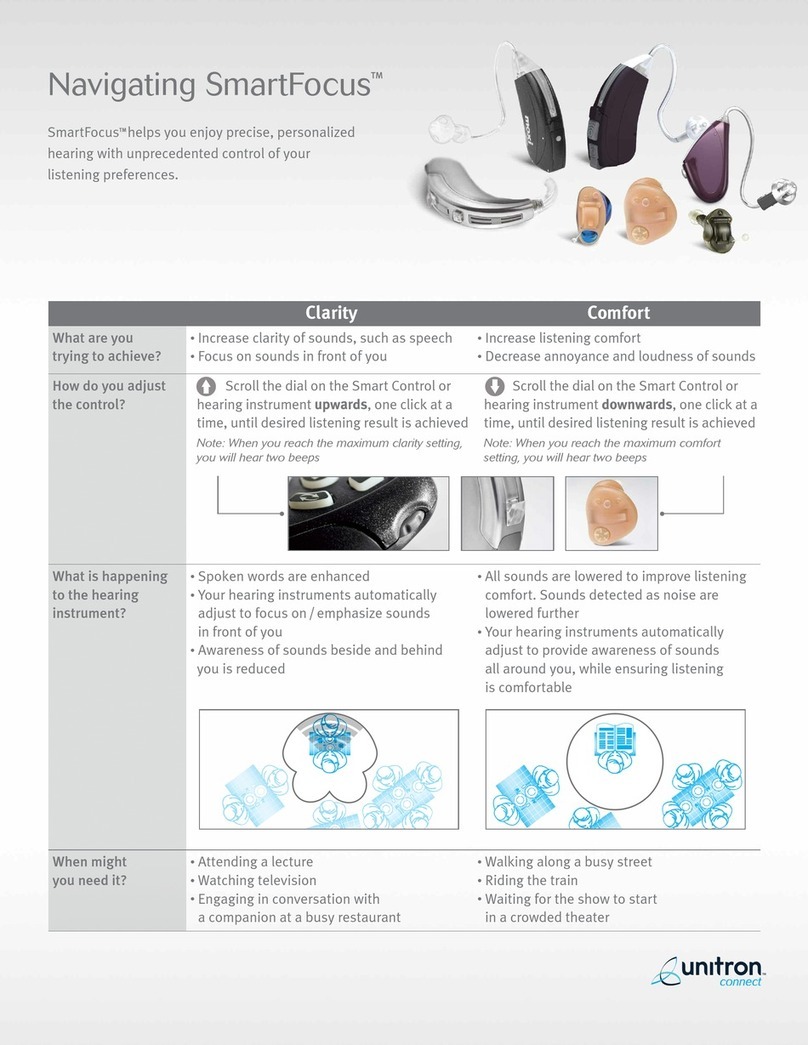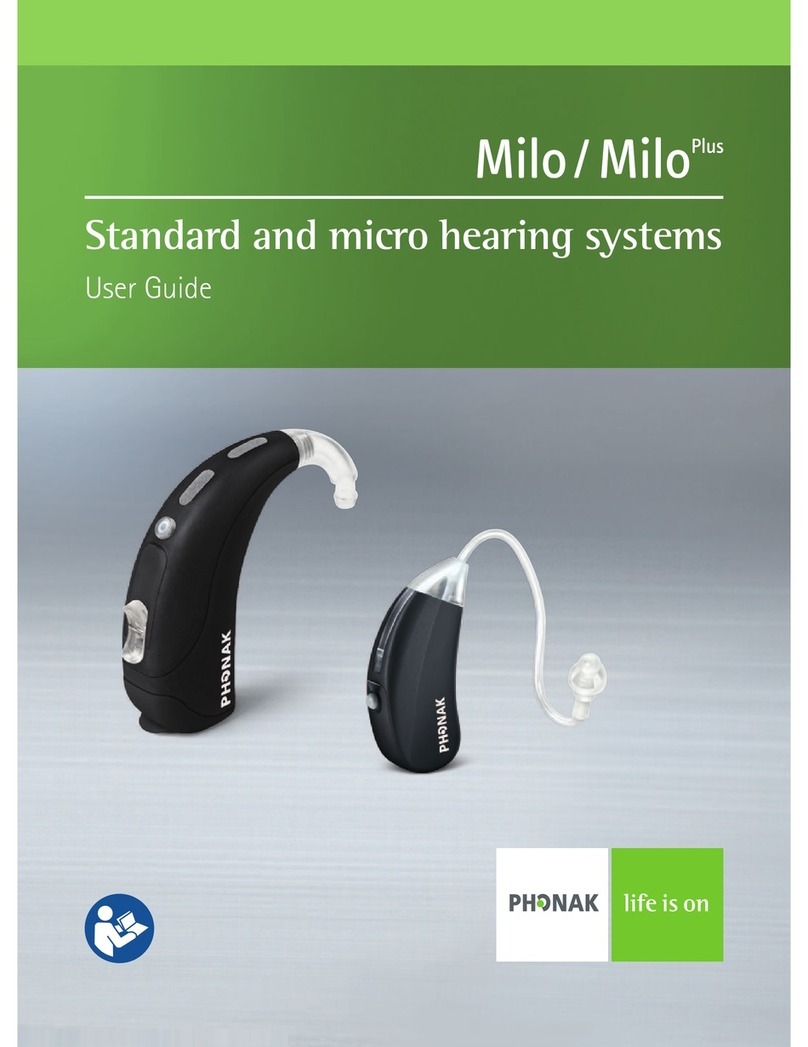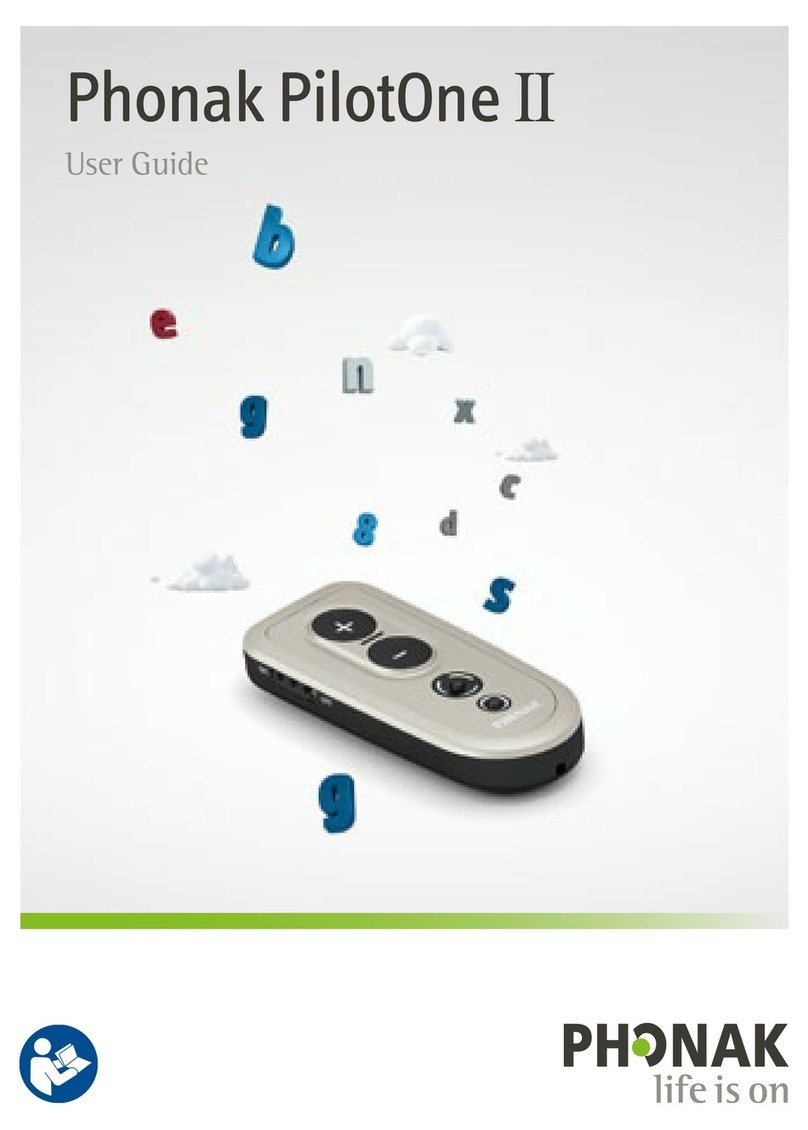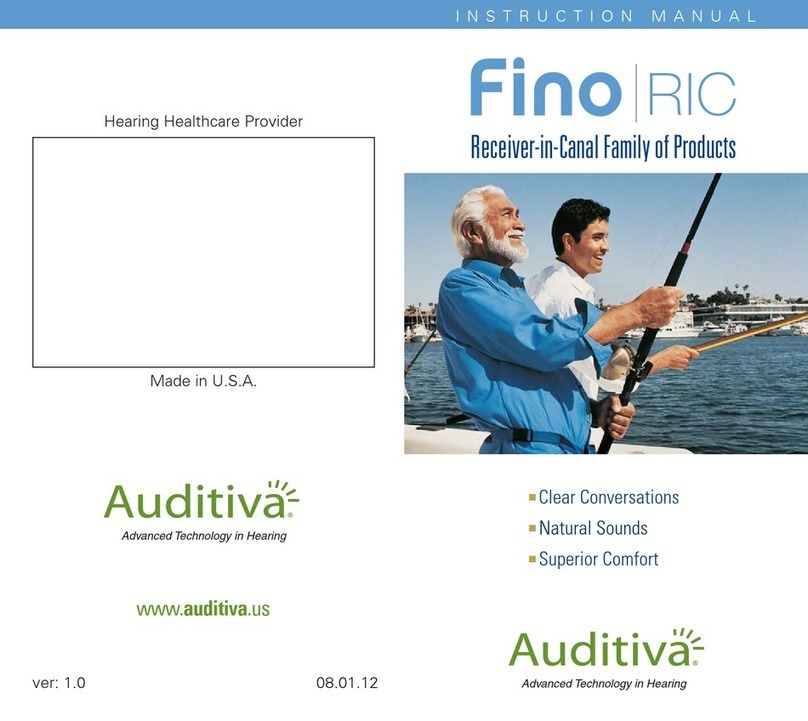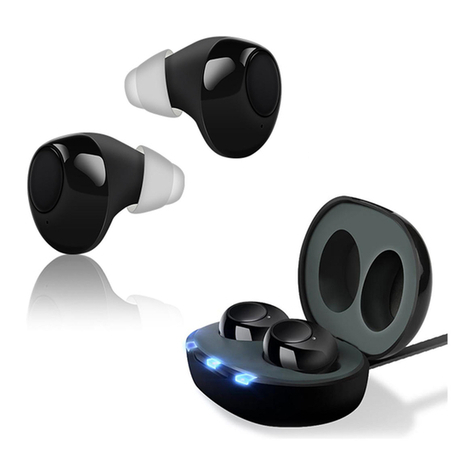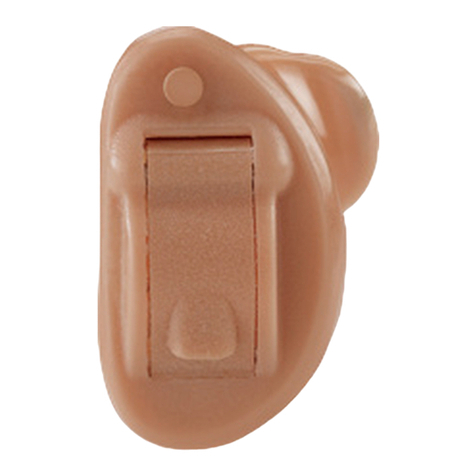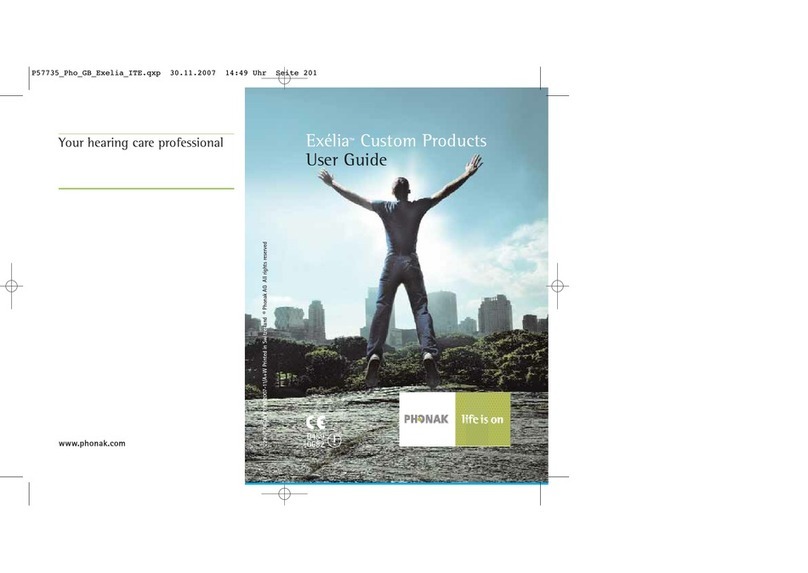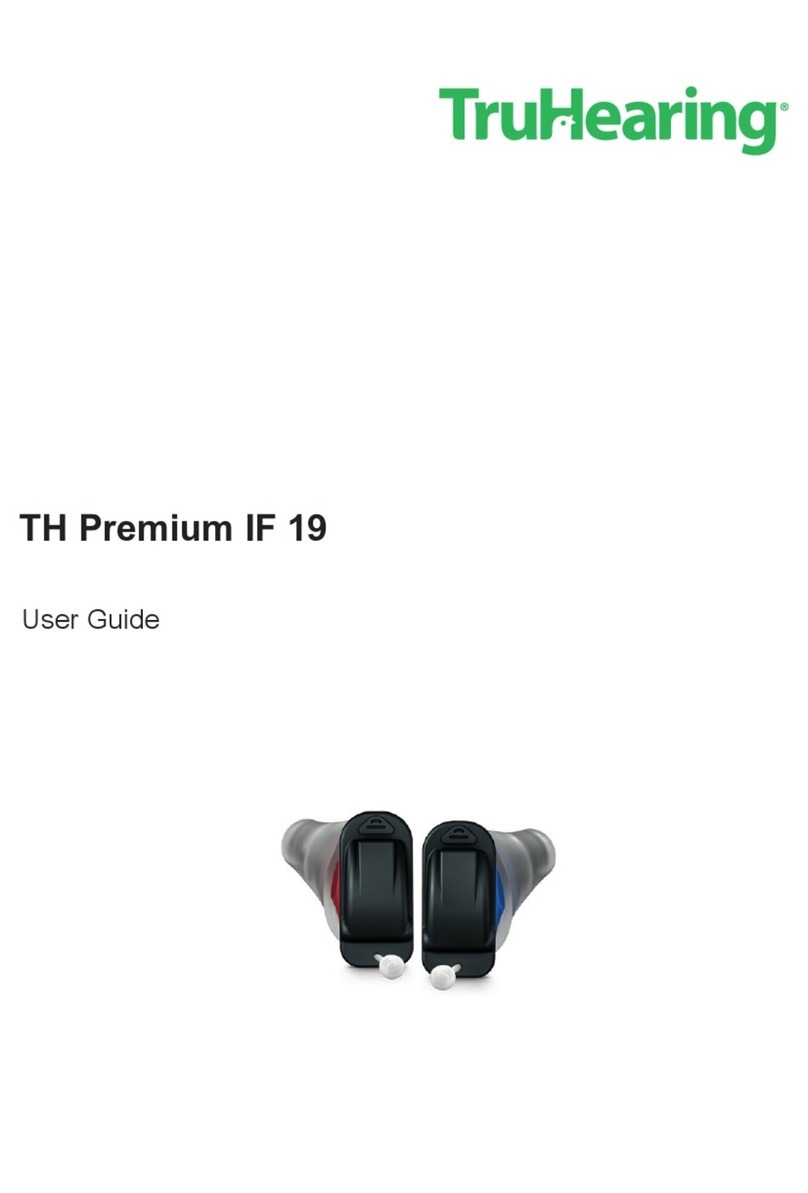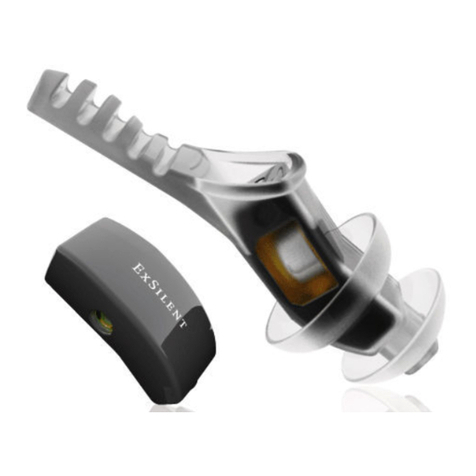Linner Mercury User manual

OTC RIC Hearing Aids
Quick Start Guide

(07-12)
(03-06)
(13-45)
1 2
TABLE OF CONTENTS
Know Your Hearing Aids
Use Your Hearing Aids
Trouble Shooting
Global customer service
If you encounter with any quality issue, please feel free to
contact our support team, we are always glad to help.
Warranty
The warranty period for LINNER Mercury is one year from the
date of purchase.
+1(888) 819-1558 ( 9am - 5pm Mon-Fri Pacific Time )
( response within 24hours )
( FAQ / instruction video )
www.linnerlife.com

Interfaces
Structure
1
2
4
5
3
6
3 4
Know Your Hearing Aids
Power ON/OFF Volume Control/
Program Switch
Shell
Microphone Receiver Ear Domes
(The appearance shall be subject to the actual situation)
12 3
4 5 6
01
Interfaces
Accessory

Accessory Controls
Volume
Control
Mode
Switch
Left ear volume
Left ear volume
Right ear volume
Right ear volume
Click upper button for once
Click bottom button for once
Click upper button for once
Click bottom button for once
Left ear previous mode
Left ear next mode
Right ear previous mode
Right ear next mode
Hold upper button for 2s
Hold upper button for 2s
Hold bottom button for 2s
Hold bottom button for 2s
5 6
Cleaning
tool
Replaceable
tips
Extra
domes
Type-C
charging cable Item Function Operation
Power
Control
Power on
Power off
Slide down power button
Slide up power button
Power Button
Volume+/Mode+
Volume-/Mode-

Charging
Put hearing aids into charging
case, the charging case will
charge hearing aids automati-
cally.
Connect charging case to any
active charging port with included
charging cable.
7 8
Use Your Hearing Aids
02
Charging
Wearing
Power on/off

Wearing
9 10
1) Fit Ear Domes
Remove earplus: pinch the eraplugs
with your thumb, index finger and
middle finger to separate the
earplugs from the connector.
Select appropriate earplugs
according to the size of the ear
canal, hold the earplugs and fit
them into the connector of the
hearing aid. They are required to be
fitted in place.
2) Fit Earplugs
Hold the bottom of the tube
with your fingers and gently
push the earplug into the ear
canal.
3) Wear hearing aids
Put the hearing aid behind the
ear, and close to the head and
comforatably over the pinna.
4) Adjust hearing aids

Power on/off
Slide down power button, hearing
aids will turn on, the hearing
amplification will be enabled after 5
seconds.
Power on
Slide up power button, the hearing
aids will turn off.
Power off
Battery life
Take off the hearing aids
behind the ears.
Hold the bottom of the sound tube
and pull it gently. After the earplug
is losse, take it out and take it off
together with the hearing aids.
5) Remove hearing aids
11 12
The hearing aids can work for more than 20H when the battery is fully
charged. The full charging boxes can charge hearing aids 3 times.
Model:FHE512,
Input:DC5V 200mA,
Output:DC4.2V 50mA,
Battery:DC 3.7V 300mAh 1.1Wh
Power Adapter:
Input:100-240V~50/60Hz, max 150mA,
Output:DC5V 1A.

Trouble Shooting
Problem Cause Solution
Whistling
Hearing aids is not worn correctly
Too much earwax
Hearing aids is not worn correctly
Clean earwax or contact with an audiologist
Silent
Power off
Low battery or no power
Dirt blocks the earplug or tube
Small
sound
Low volume
Low battery
Hearing aid is damped
Dirt blocks the earplug or tube
High power
Consumption
Intermittent
Sound
Hearing aid is still on when not in use
Hearing aid is damped
Dirt blocks the sound tube
Dirt blocks the earplugs
If the above methods still cannot solve the problem, please contact the customer service center of our
company directly.
Clean the earplugs
Clean the sound tube
Dehumidify it with a dry box
Please turn it off when hearing aid is not in use
Clean the sound tube or the earplugs
Dehumidify it with a dry box
Charge the hearing aids
Turn up the volume
Clean the hearing aids
Charge the hearing aids
Turn it on
03
Trouble Shooting
Hearing Aid Maintenance and
charging boxes
Hearing Aid Maintenance
Others
Product Information
13 14
Trouble Shooting

please clean and maintain the
charging boxes regularly.
During the use of hearing aids, earwax
(cerumen) produced by the ears will
accumulate in the ear canal and the sound
hole of the hearing aid. A large amount of
accumulated earwax will affect the use effect
of the hearing aid, so please clean your ear
canal and maintain the hearing aid regularly.
Remove the ear domes from the hearing aid,
clean the earwax with a cleaning cloth
orwash the ear domes with clean water, and
wipe the ear domes dry. Please make
surethere are no water droplets left. lf there
are tools like blowing balloons, you can
useblowing balloons to dry the water droplets.
a) Clean Ear Domes
1.Remove Ear Domes
Hold the ear domes and sound tube connector with your left and
right handsrespectively to separate the ear dome and sound tube.
2. Fit Ear Domes
b) Replace Ear Domes
15 16
Hearing Aid Maintenance and charging boxes

Remark: Special drying box needs to be purchased separately.
Please clean your hearing aid with a dry soft cloth.
When wiping or cleaning the hearing aid, please do it on a soft desktop
(for example,put a soft towel on the desktop) to avoid damage caused
by accidental falling of the hearing aids and charging box.
Remember: do not use any liquid to clean the hearing aid and
c) Clean Hearing Aid and charging box
Please put the hearing aid in a special drying box to keep away
from damaging moisturebefore sleeping every night for
extending the life of the hearing aid.
d) Dehumidification for Hearing Aids:
If you don' t use them when going out, please put the hearing
e) Anti-vibration:
CAUTION
CAUTION
17 18

Hearing Aid Maintenance
a) Dehumidification :
Any form of moisture is influential for hearing aid, dehumidification
can extend the life ofthe hearing aid. Avoid using or storage in humid
environment, and please dry the hearingaid on a regular basis.
b) Water Prevention:
Avoid hearing aid contact with water. Remove the hearingaid when
you are swimming, taking a shower, washing yourhair, washing your
face. If hearing aid accidentally falls intothe water, do not use dryer to
dry it. You can dry it with a softclean cotton cloth and put it in a
ventilated environment.Ifa failure occurs, please contact with your
local audiologist or contact with the stafffrom customer service
center.
c) High Temperature Prevention:
Never exposing hearing aids on extreme temperatures orprolonged
exposure to sunlight.
d) Falling Prevention:
Please do not drop your hearing aids or knock them against hard
e)Precautions for Electromagnetic Compatibility
- Classification by anti electric shock type: Internal power supply
equipment.
- Classification according to the degree of protection against electric
shock: Type B application part.
- Classification by operation mode: Continuous operation equipment.
Notes: The Hearing Aid conforms to IEC60601-1-2 EMC and IEC
60118-13 requirements.
It is the responsibility of the user to ensure the electromagnetic
compatibility environment of the instrument to function properly.
User must install and operate the device based on the provided EMC
information.
It is recommended to evaluate the electromagnetic environment
before using the instrument to ensure that the surrounding
environment will not cause strong electromagnetic interference to
the instrument, otherwise it may interfere with the normal operation
of the equipment.
19 20

Instructions for use: The ME EQUIPMENT or ME SYSTEM is suitable for
healthcare environments and so on.
Warning: Only the power adapter and battery approved by manufac-
turer can be used. In order to avoid damage to the instrument, please
do not change the charging parts.
Even if other devices meet the emission requirements of the
corresponding national standards, the Hearing Aid may still be
interfered by other devices.
Warning:In the home environment, this equipment may cause radio
interference, so protective measures should be taken. It is forbidden
to use the equipment near strong radiation source (such as unshield-
ed RF source), otherwise it may interfere with the normal operation of
the equipment.
Warning: Portable or mobile RF communication device might
influence the performances of Hearing Aid, please avoid strong
electromagnetic disturbance while using, such as close to the
Hearing Aid, microwave oven, etc .
Warning: Use of this equipment adjacent to or stacked with other
Warning: Portable RF communications equipment (including
peripherals such as antenna cables and external antennas) should
be used no closer than 30 cm (12 inches) to any part of the Hearing
Aid, including cables specified by the manufacturer. Otherwise,
degradation of the performance of this equipment could result.
Warning:Use of accessories, transducers and cables other than
those specified or provided by the manufacturer of this equipment
could result in increased electromagnetic emissions or decreased
electromagnetic immunity of this equipment and result in
improper operation.”
Warning:Do not approach active high-frequency surgical
equipment and magnetic resonance imaging systems in radiofre-
quency shielded rooms, where the intensity of EMI disturbances is
high.
Warning: Do not near active HF surgical equipment and the RF
shielded room of an ME system for magnetic resonance imaging,
where the intensity of EM disturbances is high.
Warning: Make sure that all electrical accessories connected to the
Hearing Aid must comply with IEC 60601-1, if in doubt, consult the
21 22

technical service department or your local representative.
Warning: No unauthorized modification allowed of the ME EQUIP-
MENT.
According to the design purpose, the equipment complies with EMC
regulations. Including the allowable electromagnetic interference
level and necessary electromagnetic shielding performance of the
electronic equipment specified by laws and regulations.
The complete elimination of electromagnetic interference is almost
impossible unless all equipment that may produce high-frequency
signals are excluded. Although some high-frequency equipment itself
meets the requirements of EMC regulations, it is impossible to
determine whether the radio signal generated by its high-frequency
transmitter will affect the normal operation of the equipment when it
works with considerable power near the equipment order to ensure
the electromagnetic compatibility of the equipment, the equipment
needs to be installed, debugged and used according to the attached
documents. In case of such situation, please contact the personnel of
the company for solution.
This equipment generates, uses, and can radiate RF energy and, if not
installed and used in accordance with the instructions, may cause
harmful interference to radio communications. However, there is no
guarantee that interference will not occur in a particular installation. If
this equipment does cause harmful interference to radio or television
reception, which can be determined by turning the equipment off and
on, the user is encouraged to try to correct the interference by one or
more of the following measures:
- Operate in strict accordance with the instructions of the Hearing Aid
instruction manual to ensure that the device is not subject to
electromagnetic interference.
- Keep other devices away from this device to reduce the effects of
electromagnetic interference.
- Reorient or relocate the receiving antenna. The effect of electromag-
netic interference can be mitigated by adjusting the relative
position/mounting angle between the device and other devices.
- Reduce electromagnetic interference by changing the wiring location
of other device power/signal cables.
- Reduce electromagnetic interference by changing the power path of
other devices.
23 24

The Hearing Aid uses RF energy only
for its internal function. Therefore, its
RF emissions are very low and are
not likely to cause any interference in
nearby electronic equipment.
The Hearing Aid suitable for use in
all establishments, including
domestic establishments and those
directly connected to
the public low-voltage power supply
network that supplies buildings used
for domestic purposes.
RF emissions CISPR 11
Harmonic emissions
IEC61000-3-2
Voltage fluctuations/flicker
emissions IEC61000-3-3
Class B
Class A
Complies
TABLE 1 TABLE 2
Guidance and manufacturer’s declaration-electromagnetic emission Guidance and manufacturer’s declaration-electromagnetic
The Hearing Aid The Hearing Aid is intended for use in the electromagnetic environment specified below.
The customer or the user of the Hearing Aid should assure that it is used in such an environment.
The Hearing Aid is intended for use in the electromagnetic environment specified below.
The customer or the user of the Hearing Aid should assure that it is used in such an environment.
Immunity test
Electrostatic
discharge (ESD)
IEC61000-4-2
Electrical fast
transient/burst
IEC61000-4-4
Surge IEC
61000-4-5
± 2 kV for power
supply lines
± 1 kV for i
nput/output lines
± 1 kV differential
mode
± 2 kV common
mode
± 1 kV differential
mode
± 2 kV for power
supply lines
±8 kV contact
±2, 4, 8, 15 kV air
±8 kV contact
±2, 4, 8, 15 kV air
Floors should be wood, concrete
or ceramic tile. if floors are
covered with synthetic material,
N/A
N/A
IEC60601 test level Compliance level Electromagnetic environment -
guidance
Emissions test
RF emissions
CISPR 11 Group 1
Compliance Electromagnetic environment-guidance
25 26

27 28
TABLE 3
Voltage dips,
short interruptions
and voltage variations
on power supply
input lines
IEC61000-4-11
Power frequency
( 50Hz/60Hz) magnetic
field IEC61000-4-8
NOTE: UT is the a.c. mains voltage prior to application of the test level.
30A/m 30A/m
Dips: 0% UT for 0.5 cycle
at 0°, 45°,90°,135°,180°,
225°,270 and 315° 0%
UT for 1 cycle at 0°
70% UT for 25 cycles
(50Hz), 30 cycles
(60Hz) at 0°
Interruptions: 0% UT for
250 cycles (50Hz),
300 cycles (60Hz)
70% UT for 25 cycles
(50Hz), 30 cycles
(60Hz) at 0°
N/A
Interruptions: 0% UT for
250 cycles (50Hz),
300 cycles (60Hz)
Power frequency
magnetic fields should
be at levels characteristic
of a typical location in a
typical commercial
or hospital environment.
Dips: 0% UT for 0.5 cycle
at 0°,45°,90°,135°,180°,
225°,270 and 315° 0%
UT for 1 cycle at 0°
0.12 0.23
0.38 0.73
1.2 2.3
3.8 7.3
0,01
0,1
1
10
100 N/A
N/A
N/A
N/A
N/A
12 23
Recommended separation distances between portable and
mobile RF communication the equipment
The Hearing Aid is intended for use in an electromagnetic environment in which radiated RF disturbances are
controlled. The customer or the user of The Hearing Aid can help prevent electromagnetic interference by
maintaining a minimum distance between portable and mobile RF communications equipment (transmitters)
and the Hearing Aid as recommended below, according to the maximum output power of the
communications equipment.
For transmitters rated at a maximum output power not listed above, the recommended separation distance
in met ers (m) can be determined using the equation applicable to the frequency of the transmitter,
where P is the maximum output power rating of the transmitter in watts (W) according to the transmitter
manufacturer.
NOTE 1 : At 80 MHz and 800 MHz, the separation distance for the higher frequency range applies.
NOTE 2 : These guidelines may not apply in all situations. Electromagnetic propagation is affected
by absorption and reflection from structures, objects and people.
Rated maximum output
power of transmitter
W(Watts)
Separation distance according to frequency of transmitter M (Meters)
150kHz to 80MHz
d=1.2
80MHz to 800MHz
d=1.2
80MHz to 2,5GHz
d=2.3

Others
29 30
-The button should be used correctly and pressed gently as far as
possible to avoid excessive force.
-The hearing aid professional for RECD measured to correct target
of fitted OSPL90.
-Only to connect to equipment that conforms with international
safety standards, if externally
connected.
-This product will not restore normal hearing and will not prevent
or improve hearing impairment resulting from organic conditions.
This product is designed to help you make greater use of your
remaining hearing. You should keep in mind that it can take time
to become accustomed to hear new sounds.
-For best results, using the hearing aids as much as possible. In
most of time, infrequent use of the hearing aids doesn’t permit you
to attain full benefit from them.
-The use of a hearing aid is only part of hearing rehabilitation and
may need to be supplemented by auditory training and instruction
in lipreading.
Unpack and Check
· After unpacking, please check the actual category and quantity of
accessories.
· Check the model marked on the manual is consistent with the
model of hearing aid.
Contraindication
Patients with acute otitis external, tympanitis, chronic suppurative otitis media (in
the period of purulent infection), acute suppurative otitis media and allergic to
this material. Fitting hearing aid shall be undergone professional hearing test and
fitting, and be used under the professional guidance of a doctor or a audiologist.
CAUTION

31 32
Symbol for “Date of manufacture”
Symbol for “MANUFACTURER”
Symbol for “User Guide must be read”
Symbol for “Caution and warning”
Symbol for “Fragile, handle with care” Symbol for “SERIAL NUMBER”
SN
MD
Symbol for “Note”
Symbol for “Keep dry”
Symbol for “Use-by date”
Symbol for “Consult instructions for use”
Type B Applied Part
Indicates the device is a medical device
Indicates a carrier that contains
unique device identifier information
Indicates a medical device that needs
protection from light sources
The harmful substances in the product
meet the limited requirements.
This marking shown on the product or its literature, indicates that it should not be disposed of,
with other household wastes at the end of its working life. To prevent possible harm to the
environment or human health from uncontrolled waste disposal, please separate this from
other types of wastes and recycle it responsibly to promote the sustainable reuse of
material resources.
IP22
During transport or storage, the temperature should not
exceed the limit values of -20° to 50° Celsius for a long
period of time.
The air pressure range between 86 and 106 KPa is
appropriate.
During transport or storage, the relative humidity should not
exceed the limit values of 0% to 93% for a long period of
time.
UDI
IP22: The first number 2: Protected against
solid foreign objects of 12,5 mm and
greater. The second number: Protected
against vertically falling water drops when
enclosure titled up to 15º
-20°C
50°C
86KPa
106KPa
93%
0%
Manufacturer:Austar Hearing Science & Technology (Xiamen) Co., Ltd.
Address: Building B8, Biomedical Industrial Park, No. 2064 Wengjiao West Road,
Haicang District, Xiamen, China
Preparation date: 2023.06
For eachwarning and safety sign, the nature of the HAZARD, likely consequences that
could occur ifthe advice is not followed, and the precautionsfor reducing the RISK.

Product Information
33 34
Main Application and Scope
Digital rechargeable RIC hearing aid is an assistive instrument which
is used for compensation of the patient' s hearing loss. lt is applicable
for the hearing loss with conductive, sensorineural and mixed-typed
hearing loss caused by senility, tympanitis and disease etc.
Product Model
FHE512
Program Features
P1
P2
P3
Normal Output
Low Frequency Cut and High Frequency Cut
High Frequency Cut
Program Setting
Environment and ConditionsWorking environments:
Temperature:0°C~+40°C, (32°F ~ 104°F), Humidity:0%~80%RH,
Voltage:DC 1.4V.Storage environments:
Temperature:-20°C~+50C, (-4°F ~ 122°F), Humidity:0%~93%At-
Storage conditions: Room temperature, clean, dark, no corrosive gas and well
ventilated room.
Transportation conditions: The packaged hearing aids can be transported by general
cargo transportation method, and shall be protected from rain, exposure and collision
during transportation.

35 36
Technical Specifation
THD at
Latency
(ms)
500Hz 800Hz 1600Hz
≤5
%
<6 ≤5
%
≤5
%
HFA
FOG
(dB)
Peak
Gain
(dB)
HFA
OSPL90
(dB)
MAX
OSPL90
(dB)
Model
FHE512
<117 105 35 30
100 500
Battery
Current
Drain(mA)
Eq. Input
Noise Level
(dB)
Frequency
Range
(Hz)
Model
FHE512
F1≤200;F2≥5000 <32 ≤2
Release
Time
(ms)
Attack
Time
(ms)
35
Hearing aid is built in the rechargeable Lithium battery, please
dispose of the afterused battery regarding of local regulations to
protect the environment.
lmpact on the Environment
Danger: To avoid being swallowed by children in accident, please keep
the hearing aid away from children.
-Those who have undergone ear canal surgery are not recommended to
buy this product directly. They should go to the hearing center to consult
with an audiologist or a doctor before purchasing.
-A hearing aid should not be applied to both ears at the same time.
Because the hearing loss of the right or left ear is different.
In case of battery leakage, please stop using the hearing aid and contact
the customer service center.
-To avoid remove the hearing aid ear dome leaving it in the ear, wear
and remove hearing aids gently.
-Hearing aid designed in a way that users cannot be unintentionally
exposed to a SPL above the fitted OSPL90 in normal condition.
For hearing aids, the patient is also the operator.
Safety
Usage Period
5 years

37 38
Response Curve
Other manuals for Mercury
1
This manual suits for next models
1
Other Linner Hearing Aid manuals


